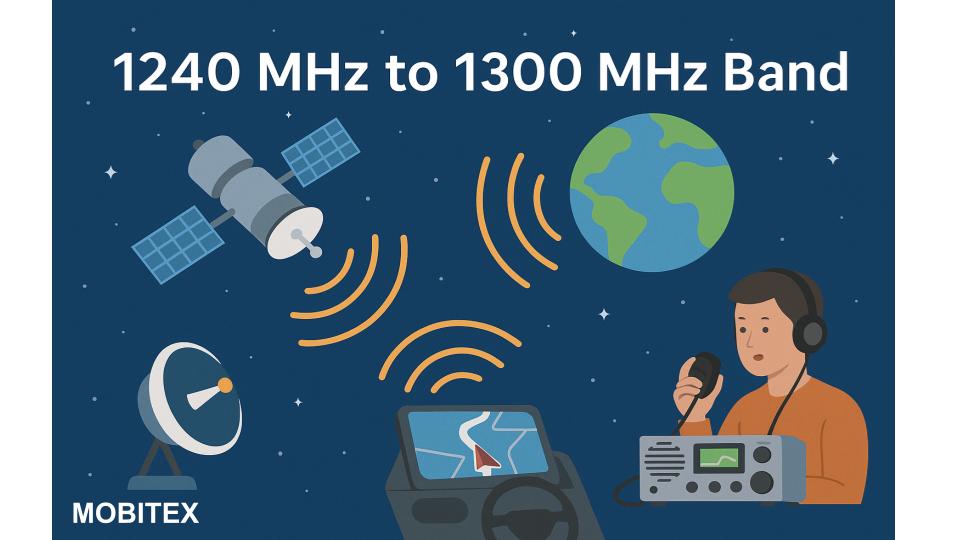The 1240–1300 MHz range, often called the “1.2 GHz amateur and radar band,” sits within the upper L-band portion of the radio spectrum. It’s a highly valuable slice of spectrum used by government radar systems, aeronautical and defense applications, satellite navigation systems, and the amateur radio community.
Overview
This 60 MHz-wide band bridges critical global services – including radiolocation, radionavigation-satellite, and amateur radio. In many countries, it’s also shared by experimental and research systems such as Earth-exploration satellites and spaceborne radars. Because of its mix of primary and secondary users, the band requires careful management to prevent interference, especially with satellite navigation systems that operate nearby.

Primary Services
1. Radiolocation (Radar)
- The dominant allocation in this range. Used for air-traffic control, defense surveillance, and weather monitoring.
- Many long-range radars rely on this band for target detection and airspace tracking.
- The band’s low noise and excellent propagation make it ideal for radar applications requiring high accuracy over long distances.
2. Radionavigation-Satellite Service (RNSS)
- Portions of this band are used by GNSS systems such as Galileo (E6) and BeiDou (B3).
- These signals, typically centered around 1278–1298 MHz, provide high-precision navigation for both civilian and military users.
- RNSS operations are co-primary with radar in most regions but must not interfere with existing radiolocation services.
3. Amateur Radio (1240–1300 MHz)
- This is the 23-centimeter amateur band, a globally recognized allocation for licensed ham radio operators.
- Applications include weak-signal communications, Earth-Moon-Earth (EME) contacts, amateur television (ATV), and satellite control uplinks.
- Amateur use is secondary, meaning operators must accept interference from – and avoid causing interference to – primary services such as radar and RNSS.
4. Earth-Exploration and Space Research
- Some spaceborne radars and remote-sensing instruments use frequencies near 1240–1260 MHz for Earth observation.
- Operations are subject to strict power and coordination limits to avoid disturbing terrestrial radar and navigation services.
Technical Characteristics
- Propagation: Excellent balance between long-range reach and resolution.
- Antenna size: Practical for compact radar systems and satellite receivers.
- Interference environment: Shared band requires high filtering and coordination to avoid overlap between radar pulses and GNSS signals.
Regulatory Context
Internationally, this band is co-allocated to:
- Radiolocation and RNSS (primary)
- Amateur service (secondary)
- Space research and Earth-exploration (conditional)
The ITU Radio Regulations specify that RNSS systems operating here must not cause harmful interference to radiolocation systems. In ITU Region 2 (the Americas), the band is also designated for amateur use under similar sharing conditions.
Real-World Uses
- Air-Traffic Control and Defense Radar: High-power radar networks for aircraft tracking and defense surveillance.
- Satellite Navigation (Galileo E6, BeiDou B3): Used for encrypted and high-accuracy navigation channels.
- Amateur Radio 23-cm Band: Experimentation, digital modes, satellite uplinks, and long-distance weak-signal contacts.
- Spaceborne Radar: Earth-observation missions using synthetic-aperture radar (SAR) technology.
Emerging Developments
- Interference Management: With GNSS signals expanding in this range, regulators are reviewing coexistence rules between amateur and RNSS users.
- Next-Generation Radar: Modern digital and phased-array radar systems continue to evolve in this band, improving detection accuracy and clutter rejection.
- Spectrum Coordination: Many administrations are re-evaluating local allocations to balance national security, navigation, and amateur use.
Summary
The 1240–1300 MHz band is a multi-service spectrum zone that connects radar, navigation satellites, and the global amateur radio community. It enables precision navigation, long-range surveillance, and advanced space research. However, because of its shared nature and critical safety-of-life uses, it remains one of the most carefully coordinated and protected bands in the L-band spectrum.
In short, 1240–1300 MHz is where innovation meets protection – a crossroads for defense, navigation, and exploration.
